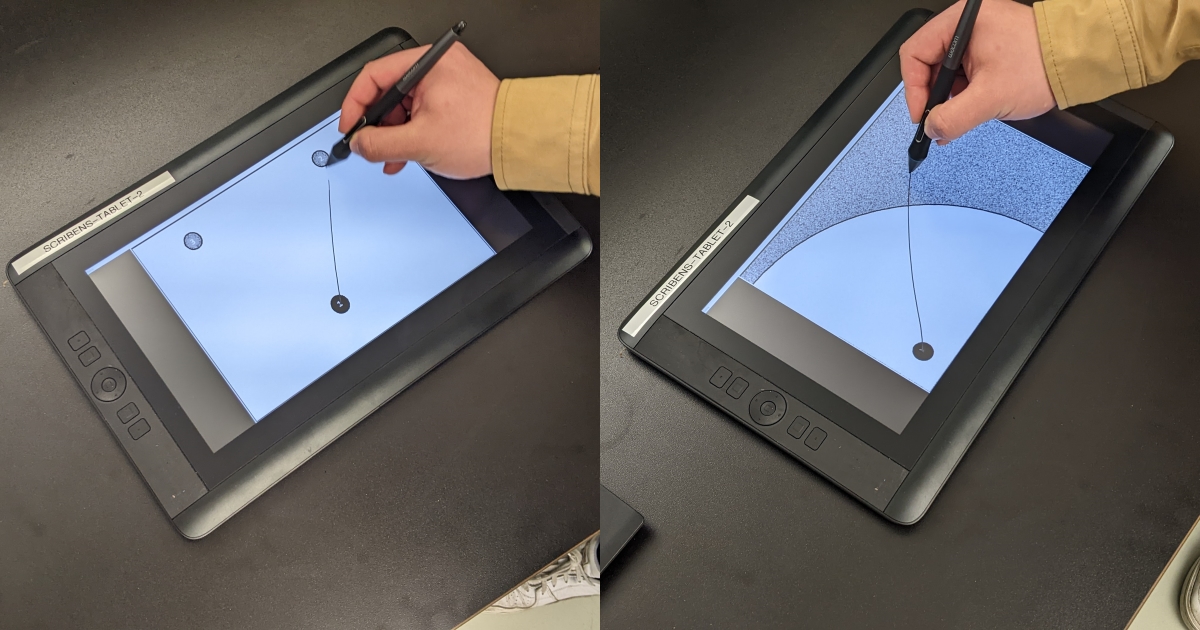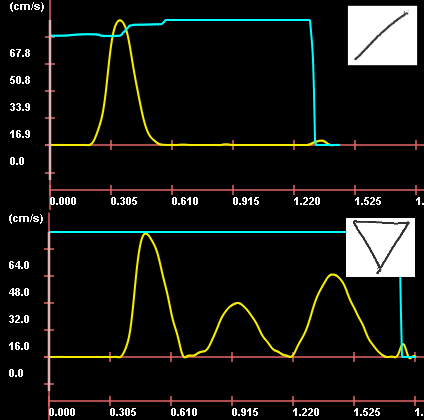Blogue
Investigating brains with a simple pen stroke


The state of an individual's fine motor skills can be assessed after they perform a series of exercises that measure both reaction speed and gesture precision. (Photo : Martin Primeau)
Clinicians will soon benefit from a new tool to measure neuromotor health, thanks to a Polytechnique Montréal team. By capturing pencil traces on an electronic tablet, those in health care will be able to obtain data about their patients’ fine motor skills - valuable information that can be used to monitor a child’s motor development, or the progression of a neurodegenerative disease in adults.
Did you know that your pencil stroke says a lot about the health of your brain? Speed of movement execution, gesture precision, and pencil pressure are all indicators of your brain’s ability to rapidly exchange information with the muscles in your hand and forearm.
Numerous signals are exchanged every second, and thanks to those signals, the brain directs independent finger movement. This is what allows us to control our fine motor skills.
The aforementioned ability develops in early childhood and allows us to manipulate objects, write, or play a musical instrument. However, certain health problems interfere with the proper functioning of this communication network. In addition to developmental disorders in children and neurodegenerative diseases in adults, strokes and old age also impair fine motor skills.
By objectively measuring these fine motor skills, clinicians could keep an eye on the progress of a disease, or confirm a person's recovery. The problem is, they don't yet have access to this kind of tool. That could change, however, thanks to a team at Polytechnique Montreal.
Deconstructing movement
 Professor Réjean Plamondon (Photo : Caroline Perron)
|
Who’s leading this helpful innovation? The team in question is led by Professor Réjean Plamondon, from the Department of Electrical Engineering at Polytechnique Montréal.
The group has developed what it calls a "lognometer" a computerized tool that deconstructs hand movements into velocity pulses that are then displayed on a graph. By evaluating how far these impulses deviate from an ideal "lognormal" result, the tool provides an objective assessment value of the state of an individual's fine motor skills.
Everything is carried out using a pencil and an electronic tablet that records pencil pressure exerted during the movement, but also, and above all, movement speed. Various exercises verify aspects of the hand movement. For example, a person will be asked to connect three points as quickly as possible to form a triangle. In another example, there is the measurement of "volition time", i.e. the time taken to make a decision following a sound or visual signal.
"Our tool allows us to separate the motor and brain components of movement in an objective way," explains Professor Plamondon. "With this information, a clinician can then determine if a patient needs a particular treatment.”
He notes that such a tool could also be used to assess recovery speed in someone who has suffered a concussion, or to determine if a certain treatment is working. The latter could for example include older individuals with Parkinson's disease, or adults experiencing the aftermath of a stroke.
In children, it could be used as a reference tool during each medical examination to assess the development of fine motor skills, "a bit like a growth curve" comments the Professor. The tool could also be used to see whether a child suffers from an attention deficit disorder that could lead to problems in the development of fine motor skills.
A matter of... log-normality |
|
The tool developed by Professor Plamondon and his team is based on the theory that the acceleration and deceleration of a movement follow a characteristic curve called "log-normal." As a matter of fact, Plamondon even wrote a book on the subject in 2020. "Many movements such as eye saccade or head rotation follow this curve," says Plamondon. "Fine motor movements also follow this curve, unless a disease or accident interferes with the normal functioning of the brain and forearm.” |


 By plotting the speed of pencil movement at different times during an exercise, a so-called "lognormal" curve (in yellow) appears, characterized by rapid acceleration at the beginning of the movement, followed by a slower deceleration towards the end. A curve representing pencil pressure (in cyan) is also displayed. Here we see two trials where the pencil trace is highlighted (white square). The first test shows a simple line (top), and the second a triangle formed by connecting three points (bottom). (Crédit : Guillaume Seguin De Broin et Martin Primeau)
By plotting the speed of pencil movement at different times during an exercise, a so-called "lognormal" curve (in yellow) appears, characterized by rapid acceleration at the beginning of the movement, followed by a slower deceleration towards the end. A curve representing pencil pressure (in cyan) is also displayed. Here we see two trials where the pencil trace is highlighted (white square). The first test shows a simple line (top), and the second a triangle formed by connecting three points (bottom). (Crédit : Guillaume Seguin De Broin et Martin Primeau)


Comments
Commenter
* champs obligatoire